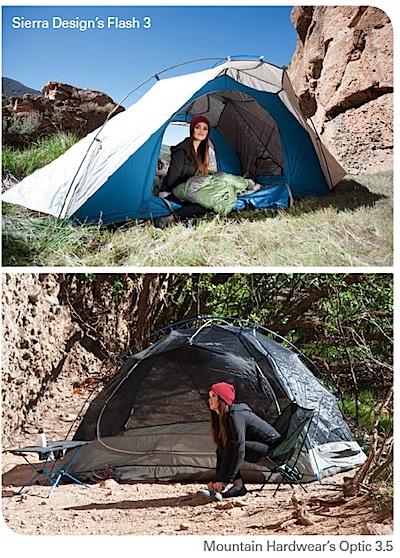
Two three-person tents perfect for two/Patrick Cone
Let's face it, backpacking tents are cut small, almost ensuring a packed sardine feeling for their occupants. While it's nice to snuggle up with your significant other, sometimes that generates way too much heat, and shifting positions can wake your partner.
Fortunately, there are times when you have some leeway to avoid that cramped feeling, such as when you're paddling a canoe or kayak or car camping. These are occasions when you can haul a bit more gear without breaking your back. Sierra Design's Flash 3 and Mountain Hardwear's Optic 3.5 are a couple of three-season tents to turn to when weight isn't a driving factor. Both are designed to hold three people, which makes them wonderfully spacious for two.
Sierra Design's Flash 3
This roomy tent features an attached rainfly, something that ensures the interior stays dry from the point when it leaves its stuff sack until it's upright, a transition that takes minutes and provides you with a low-slung, wind-shedding, gale-withstanding shelter. The doors on either end are not covered by vestibules, but rather awnings that jut 17 inches out from the tent body. This makes access easy, greatly enhances visibility, and allows you to keep the door open in the rain, unless winds are whipping the precipitation sideways.
On the tent sides the fly extends a good way out, creating storage compartments on both sides to keep packs, boots, and other gear out of the weather yet within easy reach. Zippered openings in the interior walls allow you quick access to your gear. It's best that you stow your packs into these compartments from the outside once you set up the tent, particularly if it's raining or snowing. That will help keep the inside of the main compartment dry. Once you call it a night, you can easily reach your gear through the zippered windows.
Additional mesh pockets attached to the walls hold smaller items such as flashlights, wallets, and cellphones.
Good separation between the mesh interior walls of the Flash 3 (MSRP $400) and the outer rainfly provide excellent ventilation to ward off condensation on the coldest nights. Setup is quick: less than 5 minutes for one person, even quicker with a helper. Inside, you have 41 square feet of floor space and 44 inches from floor to ceiling at the peak. Packed, this tent weighs 6 pounds, 3 ounces.
Mountain Hardwear's Optic 3.5
This is another spacious, albeit slightly unusual, option for two people who like to stretch out in the backcountry. The non-traditional approach taken by the designers is to place one door on the side of the tent and another on the end. When the detachable rainfly is covering the tent, this approach provides good visibility out one side of the tent and out one end. There are, though, no windows on the other walls.
Leave the rainfly off and the mesh walls allow visibility in all directions... and great airflow. With 45 square feet of interior space, the Optic 3.5 (MSRP $285) is a bit larger than the Flash 3. It also offers 12 square feet of vestibule space to stow your gear out of the weather. At 6 pounds, 11 ounces, it's comparable in weight. The Optic 3.5 offers interior stowage space in the form of five mesh pockets for small items such as glasses, flashlights, and, if needed, bear spray.
As with the Flash 3, this tent goes up quickly. The fly reaches practically to the ground, ensuring a dry night's sleep in a downpour. But if you are willing to gamble that the night will be dry, leaving the fly off provides incredible airflow and stars to count until you doze off.
Both tents offer loops near the ceiling to install optional gear lofts or to run lines for hanging items.
How to decide which tent to go with? You could flip a coin. Or, if your normal backpacking trips take you into dry regions with little chance of rain, the Optic 3.5 provides an airy night's sleep with the rainfly left in the stuff sack until needed. If you're more concerned about precipitation, the Flash 3 is the way to go.

 Support Essential Coverage of Essential Places
Support Essential Coverage of Essential Places






